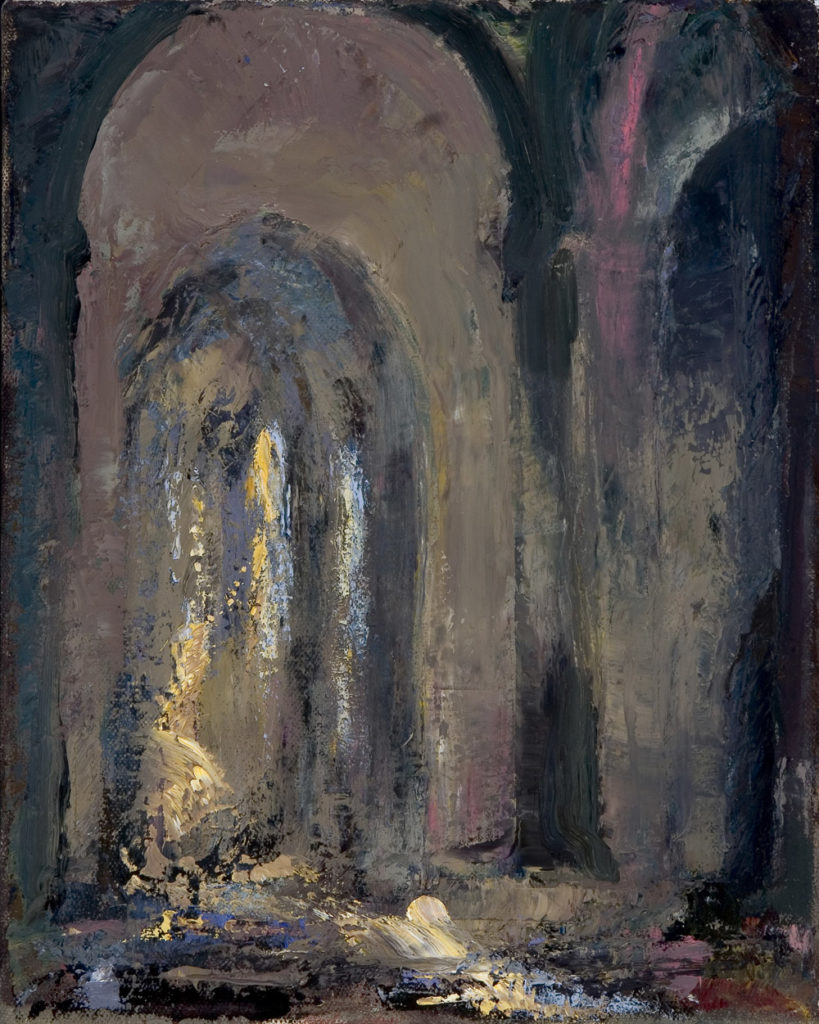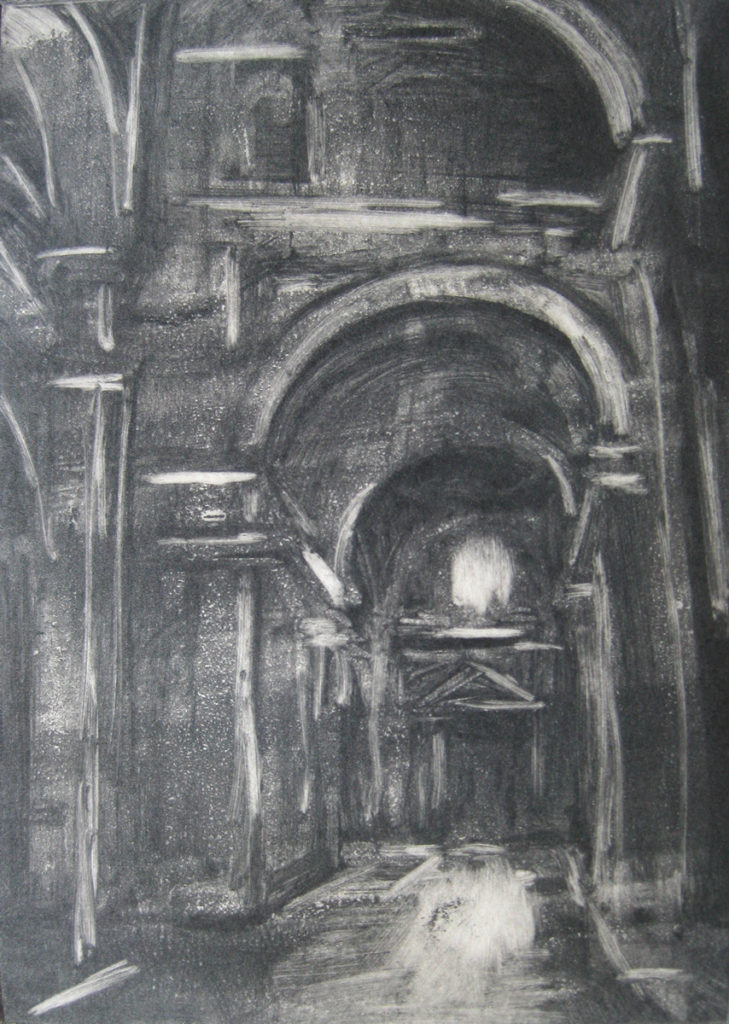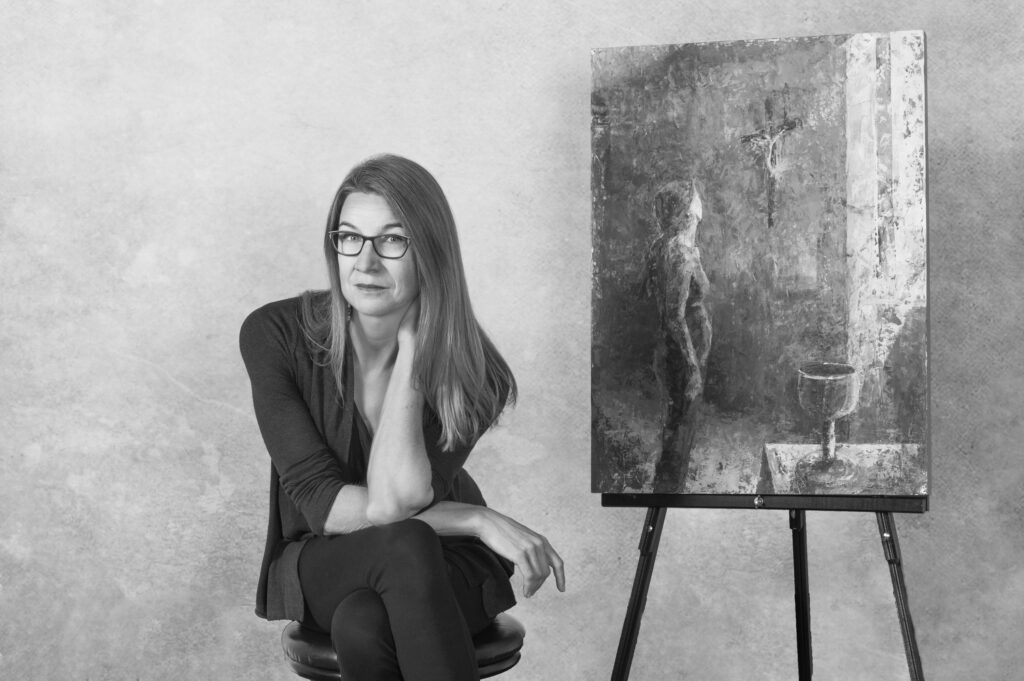
“Presence: San Francesco”, Oil on Canvas, 10″ x 8″ ©Michelle Arnold Paine 2007, Click to Purchase
Exhibit At Perrysburg Municipal Building
Communities in Northwest Ohio are thinking outside the box for ways to bring art into public spaces. My sacred architecture paintings and prints will be exhibited at the Perrysburg Municipal Building from March 6-April 24.
The exteriors of local churches shape the landscape of daily life-about-town, but their interiors have helped shape spiritual lives for centuries. In Europe, cavernous sacred spaces were built for throngs of religious activity, but now hold only shadows of those presences. The shapes of archways reaching towards heaven, the rhythm of dark and light passing through complex spaces inspire a sense of quiet awe and shadowy mystery. Though they were intended to be centers of civic and religious life, they often retain only vestiges of that importance in community life. They are also an evocative metaphor for our own interior lives – that place where there is only listening and waiting in the darkness.
Like the structures that inspired them, my paintings are layered, image covering image, sometimes sanded or scraped away so that the painting itself becomes a palimpsest of history like the ancient buildings, addressing the tension between the permanent and the passing.
Architecture: Dwelling on the Earth and Under the Sky
After I returned in 2003 from three years living and working in Orvieto, Italy, public spaces in the US felt desolate and utilitarian. The philosopher Martin Heidegger links architecture with the old German word bauen, which meant dwell: to be on the earth and under the sky. This state of existence between earth and sky has both physical and spiritual dimensions. It suggests that our earthly dwelling, our interaction with the specific space in which we live, is not purely utilitarian but has a significance which relates to our very essence as human beings.
Using sketches, photos, and memories from those years in Italy, I embarked upon a decade of drawing, painting and creating prints of sacred architecture. They have been exhibited in solo and group shows in commercial, university, and non-profit spaces, published in several artistic and literary journals, and acquired by both university and private collections.
In the architecture of churches I feel this dwelling take shape as an awareness of the divine; I sense that the architects built these spaces to be visible, tangible expressions of divine presence.
In the sacred architecture of churches I feel this dwelling take shape as an awareness of the divine. I sense that the architects built these spaces to be visible, tangible expressions of divine presence. They seem to be true dwelling places between earth and sky, intended to foster an encounter between heaven and earth. Like the cathedral builders, or Impressionist painters like Monet (whose Rouen cathedral paintings did not have the cathedral as their true subject, but rather the invisible light and air), I seek to use paint to articulate something that is without color or form. My paintings express my desire to explore the edge between visible and invisible, past and present, spiritual and physical.
These sacred architecture paintings are also an evocative metaphor for our own interior lives: that place … where there is only listening and waiting in the darkness.
The shapes of archways reaching towards heaven, the rhythm of dark and light passing through these complex spaces inspire a sense of quiet awe and shadowy mystery. These sacred architecture paintings are also an evocative metaphor for our own interior lives – that place where there is no longer thought, interest, or opinion, only listening and waiting in the darkness. Perhaps T.S. Eliot says it best in his Four Quartets:
…You are not here to verify,
Instruct yourself, or inform curiosity
Or carry report. You are here to kneel
Where prayer has been valid. And prayer is more
Than an order of words…
“Beacon”, Oil on Canvas, 20″ x 16″. Click to Purchase.
In the three years I spent living and working in Italy, I encountered these medieval places as places of mystery. After my return, I continue to find inspiration in sacred spaces, a yearning for connection and tradition and the communion of saints. Through painting these spaces they have also become metaphors for the experience of painting itself: discoveries arrived at through waiting shadows and moments of light.



